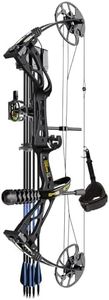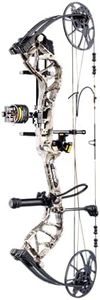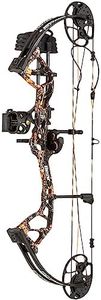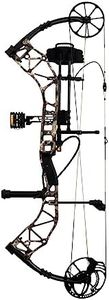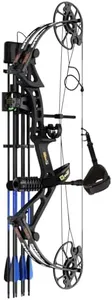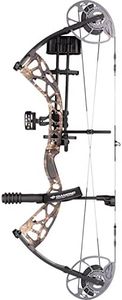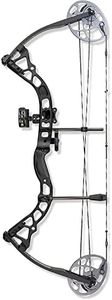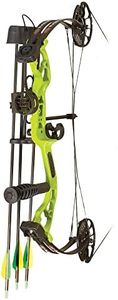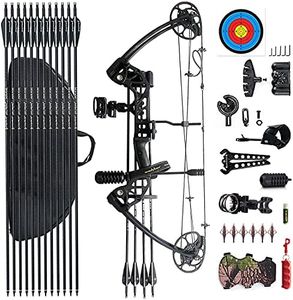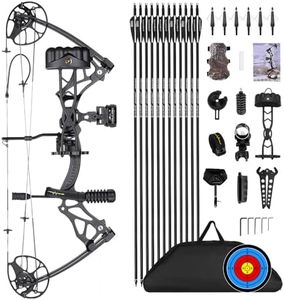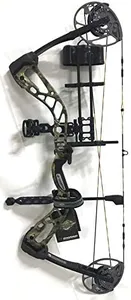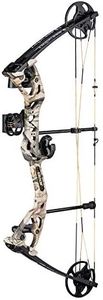10 Best Archery Compound Bows 2025 in the United States
Our technology thoroughly searches through the online shopping world, reviewing hundreds of sites. We then process and analyze this information, updating in real-time to bring you the latest top-rated products. This way, you always get the best and most current options available.

Our Top Picks
Winner
Sanlida Archery Dragon X8 RTH Compound Bow Package for Adults and Teens,18”-31” Draw Length,0-70 Lbs Draw Weight,up to IBO 310 fps,No Bow Press Needed,Limbs Made in USA,Limited Life-time Warranty
The Sanlida Archery Dragon X8 RTH Compound Bow Package is a versatile option suitable for both adults and teens, making it a great choice for a wide range of archery enthusiasts. One of its standout features is the adjustable draw length (18”-31”) and draw weight (0-70 lbs), which allows users to customize the bow to their needs without requiring a bow press. This flexibility makes it ideal for beginners and experienced archers alike. The bow boasts a respectable speed of up to 310 fps, ensuring good performance during hunts.
Included in this ready-to-hunt package are essential accessories like a 5-pin sight, stabilizer, arrow rest, quiver, and even a bow case, which adds significant value. The limited lifetime warranty also provides peace of mind regarding durability and quality, especially given the materials used, like CNC machined aluminum.
There are a few considerations to keep in mind. While the bow is lightweight at 3.8 lbs, some users may find the axle-to-axle length of 30 inches slightly less maneuverable in tight spaces. Additionally, while the bow comes with a variety of accessories, the quality of these extras can vary, and some users may prefer to invest in higher-end components as they advance in skill.
Bear Legit Maxx Ready to Hunt Compound Archery Bow, 70lb. Draw Weight, Right Hand, Veil Whitetail/Black
The Bear Legit Maxx Ready to Hunt Compound Archery Bow is designed for both beginner and intermediate archers, featuring a versatile draw weight range from 10 to 70 pounds and an adjustable draw length between 14 to 30 inches. This means it can accommodate a wide range of users, from young archers to adults, making it a good option for families or those new to the sport who want a bow that can grow with them.
One of the standout features is the improved dual cam system, which delivers consistent performance, ensuring that each shot feels reliable. The bow also has a 31-inch axle-to-axle length and a 6.25-inch brace height, providing good stability and ease of use. Included accessories like the IMS V-Biscuit rest, Picatinny-mounted Fatal 4 sight, and a 5 Spot arrow quiver enhance the value, making it a ready-to-hunt package right out of the box.
There are a few drawbacks to consider. While the bow weighs 6.95 pounds, some users may find this a bit heavy for prolonged use, especially when carrying it over long distances. Additionally, the bow is designed for right-handed users, which could be limiting for left-handed archers. It's essential for potential buyers to consider these factors and ensure it aligns with their specific needs. The Bear Legit Maxx offers a solid balance of features and performance, making it a dependable choice for many archers, but it’s wise to weigh the potential downsides before making a decision.
Bear Archery Royale Ready to Hunt Compound Bow Package for Adults and Youth, Right Hand, Wildfire
Most important from
473 reviews
The Bear Archery Royale Ready to Hunt Compound Bow Package is a versatile and adjustable option suitable for both adults and youth. With a draw length ranging from 12 to 27 inches and a peak draw weight between 5 to 50 lbs, it offers significant adaptability for varying skill levels and physical builds. This makes it an excellent choice for those who are new to archery or looking for a bow that can grow with them as their skills improve.
One of its strongest features is its lightweight design, weighing only 2.7 lbs without accessories and 3.3 lbs with them, making it easy to handle and carry around during long hunting trips. The bow is capable of shooting arrows at a speed of 290 feet per second, which is quite impressive for its weight class, providing a good balance between speed and power. Its ready-to-hunt package includes valuable accessories like the Trophy Ridge Mist sight, a 5-Spot quiver, Whisker Biscuit, Fletcher Archery No Tie Peep, and a nock loop, meaning you can start using it immediately without needing to purchase additional gear.
However, it’s important to note that it’s only available for right-handed users, which may limit its accessibility for left-handed archers. Additionally, while the adjustability is a major plus, seasoned archers looking for extremely high draw weights might find the 50 lbs peak limiting. The Bear Archery Royale RTH is an excellent all-around bow for beginners and intermediate users who appreciate versatility and ease of use, but it might not satisfy the needs of very advanced archers or those requiring left-hand orientation.
Most important from
473 reviews
Buying Guide for the Best Archery Compound Bows
Choosing the right compound bow for archery can significantly impact your performance and enjoyment of the sport. It's important to consider various specifications to ensure the bow fits your needs, skill level, and physical attributes. Understanding these key specs will help you make an informed decision and find the best bow for you.FAQ
Most Popular Categories Right Now
